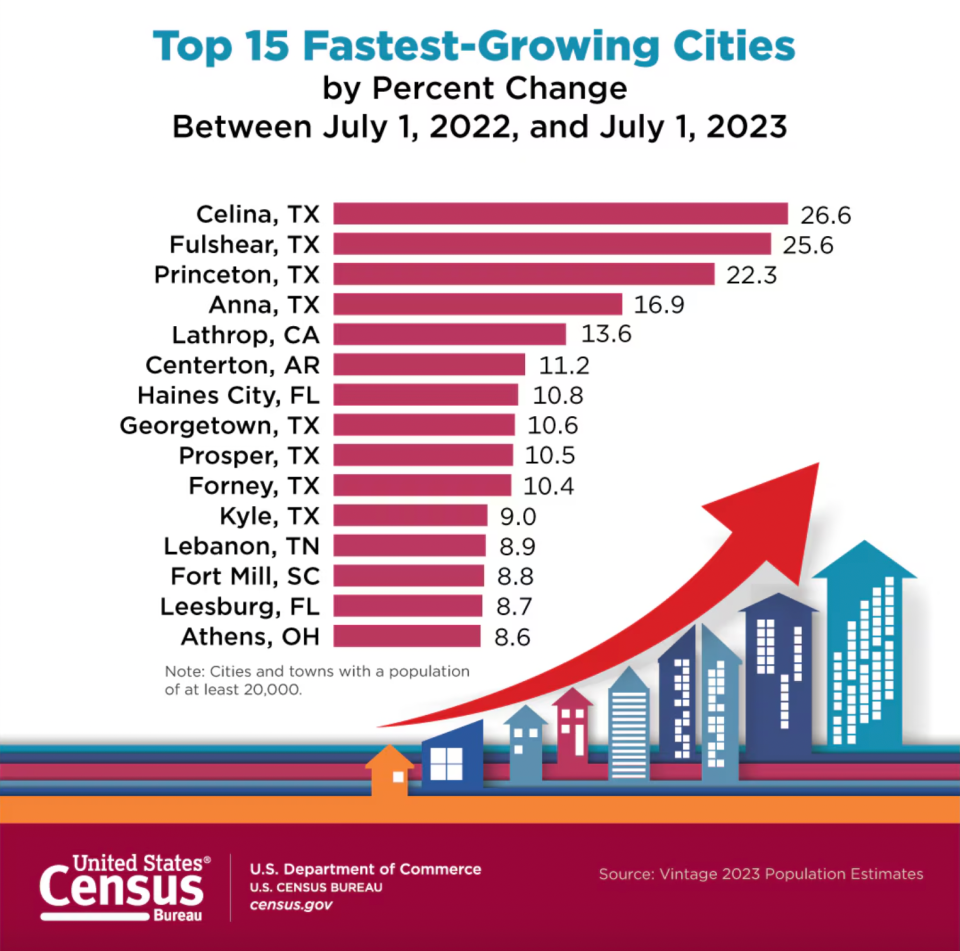6 large cities in Ohio experienced population growth last year. Here they are
Are Ohio's biggest cities growing or shrinking? What cities are growing the fastest?
Thanks to a recently-released U.S. Census Bureau report tracking population changes from July 1, 2022, to July 1, 2023, we now have the answers.
Here's what you need to know about the population shifts in the Buckeye State.
Columbus remains one of the most populous cities in the US
Columbus is among one of the 15 most populous cities in the country, with a population of just over 913,000 as of last year, according to the report. The capital city grew 0.5%, adding roughly 5,000 new residents.
Nine cities recorded 1 million or more residents, and while Columbus isn't one of them, it remains one of the most populous cities in the country:
New York, New York (8.3 million)
Los Angeles, California (3.8 million)
Chicago, Illinois (2.7 million)
Houston, Texas (2.3 million)
Phoenix, Arizona (1.7 million)
Philadelphia, Pennsylvania (1.6 million)
San Antonio, Texas (1.5 million)
San Diego, California (1.4 million)
Dallas, Texas (1.3 million)
Jacksonville, Florida (986,000)
Austin, Texas (980,000)
Fort Worth, Texas (978,000)
San Jose, California (970,000)
Columbus, Ohio (913,000)
Charlotte, North Carolina (911,000)
The Census Bureau reported that the 15 most populous cities remain the same, but a few changed positions. Jacksonville, Florida, leapfrogged Austin, Texas, for 10th place while Fort Worth, Texas, moved past San Jose, California, to take 12th place.
Athens, Ohio, checks in as one of the fastest-growing cities in the US
These cities with a population of 20,000 or more ranked in the list of fastest-growing cities in the country.
Athens made it to the list with an 8.6% population growth rate. Texas houses eight of the 15 towns on the list, including the top four spots.
Celina, Texas (26.6% growth)
Fulshear, Texas (25.6%)
Princeton, Texas (22.3%)
Anna, Texas (16.9%)
Lathrop, California (13.6%)
Centerton, Arkansas (11.2%)
Haines City, Florida (10.8%)
Georgetown, Texas (10.6%)
Prosper, Texas (10.5%)
Forney, Texas (10.4%)
Kyle, Texas (9%)
Lebanon, Tennessee (8.9%)
Fort Mill, South Carolina (8.8%)
Leesburg, Florida (8.7%)
Athens, Ohio (8.6%)

Columbus and Cincinnati weren't the fastest-growing areas in Ohio
Columbus and Cincinnati both added 0.5% to their populations, according to the Census Bureau, but they didn't have the highest rates of population growth in Ohio.
That honor goes to Washington Township.
The township in southern Montgomery County south of Dayton, which includes Centerville, grew its population 1%, going from 62,360 to 62,998 people.
Further down I-75 and north of Cincinnati, West Chester Township in Butler County saw a 0.6% population increase from July 1, 2022, to July 1, 2023. It went from 65,241 people to 65,642.
Akron, Cincinnati suburbs experience population growth
Akron (188,472 to 188,701), the city of Hamilton (north of Cincinnati; 62,936 to 62,997), Green Township (northwest of Cincinnati; 59,587 to 59,626) and Colerain Township (northwest of Cincinnati; 58,563 to 58,608) all achieved 0.1% growth from July 2022 to July 2023.
Lorain experienced modest population growth per the study, adding a handful of people to reach 65,337.
Where did Ohio lose population?
Canton and Parma suffered the steepest population declines in Ohio, according to the Census Bureau study.
The Pro Football Hall of Fame home city dipped 0.5%, going from 69,545 to 69,197 people per the study. Parma (79,360 to 78,951) also dropped 0.5%.
Toledo went down 0.4% (266,350 to 265,304).
Dayton (135,828 to 135,512), and Youngstown (59,217 to 59,108) lost 0.1% of their population.
Cleveland experienced a negligible decline, though its population remained above 362,000.
Population changes in the Midwest
Growth in Midwest cities reversed the earlier population declines, per the Census Bureau report.
Cities with populations of 50,000 or more in the Midwest grew by about 0.1% after declining an average of 0.3%.
Small towns in the Midwest slowed their population declines, decreasing by an average of 0.3% and 0.1%, respectively, compared to 0.4% and 0.2% in 2022.
This article originally appeared on Cincinnati Enquirer: 6 cities in Ohio experienced significant population growth in 2023

